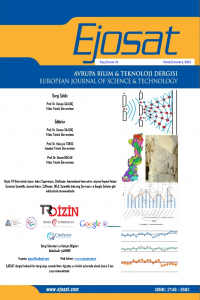Öz
Manyetik dişli sistemi sabit mıknatıslar yardımı ile elde edilen manyetik kuvvetler ile çalışan, klasik dişli sistemlerine alternatif olabilecek yapıya sahip bir aktarım elemanıdır. Giriş ve çıkış mili arasında tork iletmek için manyetik dişli sisteminde klasik dişlilerden farklı olarak mekanik bir temas olmadan iletim söz konusudur. Dolayısıyla sürtünme ortadan kaldırılmış olmaktadır. Sürtünmenin ortadan kalkması klasik dişli kutusu sistemlerine göre manyetik dişli sistemlerinin çok daha yüksek verimlerde çalışması manasına gelmektedir. Manyetik dişli sistemlerinde hareket ve tork iletimi temassız olarak gerçekleştiği için hiçbir zaman yağlama gerektirmez ve yağlamadan kaynaklanan sorunlar meydana gelmez. Geleneksel mekanik dişli kutusu sistemlerinde, çevrim oranı kullanılan diş sayısına göre belirlenir. Manyetik dişli sistemlerinde ise benzer olarak, kullanılan sabit mıknatısların sayısı çevrim oranını belirlemektedir. Bu çalışmada koaksiyel bir yapıya sahip manyetik dişli sistemi tasarlanarak sonlu elemanlar yöntemi ile elektromanyetik analizi yapılmıştır. Giriş mili ve çıkış milinde belirli hızlarda eksenel tork değerleri zamana bağlı sonlu elemanlar analizi sonucunda elde edilmiştir.
Anahtar Kelimeler
Manyetik dişli sabit mıknatıslar eksenel tork sonlu elemanlar analizi
Kaynakça
- Armstrong, C. G. (1901). U.S. Patent No. 687,292. Washington, DC: U.S. Patent and Trademark Office.
- Lubin, T., Mezani, S., & Rezzoug, A. (2010). Analytical computation of the magnetic field distribution in a magnetic gear. IEEE Transactions on magnetics, 46(7), 2611-2621.
- Frank, N. W., & Toliyat, H. A. (2011). Analysis of the concentric planetary magnetic gear with strengthened stator and interior permanent magnet inner rotor. IEEE transactions on industry applications, 47(4), 1652-1660.
- Uppalapati, K. K., Bomela, W., Bird, J. Z., Calvin, M., & Wright, J. (2013, September). Construction of a low speed flux focusing magnetic gear. In 2013 IEEE Energy Conversion Congress and Exposition (pp. 2178-2184). IEEE.
- Gerber, S., & Wang, R. J. (2013, February). Evaluation of a prototype magnetic gear. In 2013 IEEE International Conference on Industrial Technology (ICIT) (pp. 319-324). IEEE.
- Atallah, K., & Howe, D. (2001). A novel high-performance magnetic gear. IEEE Transactions on magnetics, 37(4), 2844-2846.
- Rasmussen, P. O., Andersen, T. O., Jorgensen, F. T., & Nielsen, O. (2005). Development of a high-performance magnetic gear. IEEE transactions on industry applications, 41(3), 764-770.
- Jian, L., & Chau, K. T. (2010). A coaxial magnetic gear with halbach permanent-magnet arrays. IEEE Transactions on Energy conversion, 25(2), 319-328.
- Tlali, P. M., Wang, R. J., & Gerber, S. (2014, September). Magnetic gear technologies: A review. In 2014 International Conference on Electrical Machines (ICEM) (pp. 544-550). IEEE.
- Mezani, S., Atallah, K., & Howe, D. (2006). A high-performance axial-field magnetic gear. Journal of applied physics, 99(8), 08R303.
- Atallah, K., Wang, J., & Howe, D. (2005). A high-performance linear magnetic gear. Journal of Applied Physics, 97(10), 10N516.
Öz
The magnetic gear system works with magnetic forces obtained with the help of permanent magnets and has a structure that can be an alternative to classical gear systems. In order to transmit torque between the input and output shaft, unlike conventional gears, there is a transmission without mechanical contact in the magnetic gear system. Therefore, friction is eliminated. Elimination of friction means that magnetic gear systems operate at much higher efficiency compared to conventional gearbox systems. Since the movement and torque transmission in magnetic gear systems occur without contact, it never requires lubrication and problems arising from lubrication do not occur. In conventional mechanical gearbox systems, the conversion rate is determined by the number of teeth used. Similarly in magnetic gear systems, the number of permanent magnets used determines the conversion rate. In this study, a magnetic gear system with a coaxial structure was designed and its electromagnetic analysis was made with the finite element method. Axial torque values at certain speeds in the input shaft and output shaft were obtained as a result of finite element analysis depending on time.
Anahtar Kelimeler
Magnetic gear permanent magnets axial torque finite element analysis.
Kaynakça
- Armstrong, C. G. (1901). U.S. Patent No. 687,292. Washington, DC: U.S. Patent and Trademark Office.
- Lubin, T., Mezani, S., & Rezzoug, A. (2010). Analytical computation of the magnetic field distribution in a magnetic gear. IEEE Transactions on magnetics, 46(7), 2611-2621.
- Frank, N. W., & Toliyat, H. A. (2011). Analysis of the concentric planetary magnetic gear with strengthened stator and interior permanent magnet inner rotor. IEEE transactions on industry applications, 47(4), 1652-1660.
- Uppalapati, K. K., Bomela, W., Bird, J. Z., Calvin, M., & Wright, J. (2013, September). Construction of a low speed flux focusing magnetic gear. In 2013 IEEE Energy Conversion Congress and Exposition (pp. 2178-2184). IEEE.
- Gerber, S., & Wang, R. J. (2013, February). Evaluation of a prototype magnetic gear. In 2013 IEEE International Conference on Industrial Technology (ICIT) (pp. 319-324). IEEE.
- Atallah, K., & Howe, D. (2001). A novel high-performance magnetic gear. IEEE Transactions on magnetics, 37(4), 2844-2846.
- Rasmussen, P. O., Andersen, T. O., Jorgensen, F. T., & Nielsen, O. (2005). Development of a high-performance magnetic gear. IEEE transactions on industry applications, 41(3), 764-770.
- Jian, L., & Chau, K. T. (2010). A coaxial magnetic gear with halbach permanent-magnet arrays. IEEE Transactions on Energy conversion, 25(2), 319-328.
- Tlali, P. M., Wang, R. J., & Gerber, S. (2014, September). Magnetic gear technologies: A review. In 2014 International Conference on Electrical Machines (ICEM) (pp. 544-550). IEEE.
- Mezani, S., Atallah, K., & Howe, D. (2006). A high-performance axial-field magnetic gear. Journal of applied physics, 99(8), 08R303.
- Atallah, K., Wang, J., & Howe, D. (2005). A high-performance linear magnetic gear. Journal of Applied Physics, 97(10), 10N516.
Ayrıntılar
| Birincil Dil | Türkçe |
|---|---|
| Konular | Mühendislik |
| Bölüm | Makaleler |
| Yazarlar | |
| Yayımlanma Tarihi | 31 Ocak 2021 |
| Yayımlandığı Sayı | Yıl 2021 Sayı: 21 |

